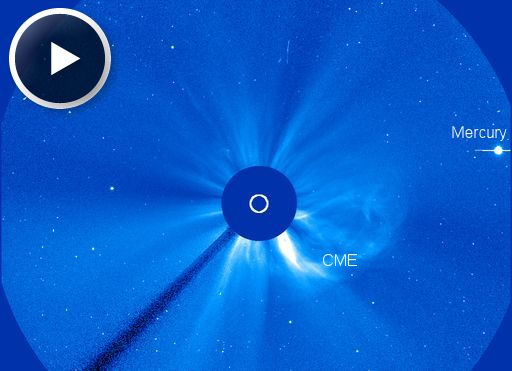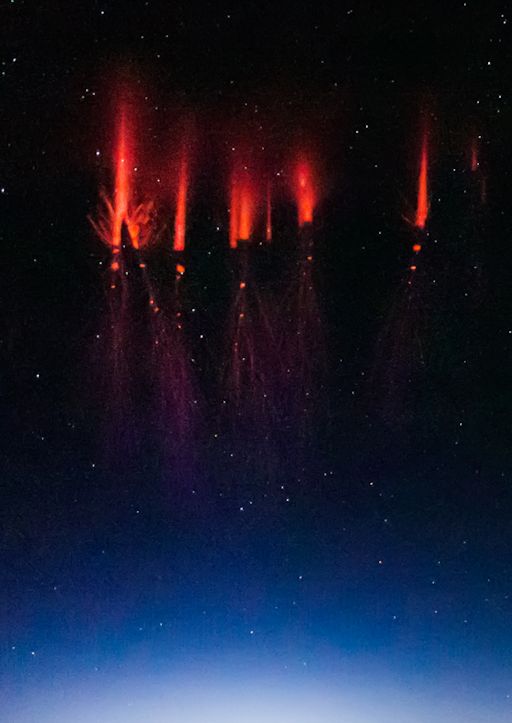Listen to radar echoes from satellites and meteors, live on listener-supported Space Weather Radio. | | |
UPDATE: CME OFF-TARGET: According to NOAA analysts, a CME hurled into space by an M-class solar flare on August 17th will probably miss Earth. However, Earth will pass through the wake of the CME after the cloud itself passes by. This could trigger polar geomagnetic storms despite the CME being off-target. High-latitude sky watchers should be alert for auroras on August 20-21. Aurora alerts: text, voice.
The Solar and Heliospheric Observatory (SOHO) photographed the CME billowing away from the sun's southwestern limb on August 17th:

Realtime Space Weather Photo Gallery
COLORFUL SPRITES OVER NEBRASKA: "August 12th was another successful night in our sprites campaign," reports Jason Ahrns of the University of Alaska Fairbanks. With a team of researchers from NCAR, he has been flying over the midwestern USA onboard a Gulfstream V in search of exotic forms of lightning. As they were photographing a thunderstorm over Nebraska, these six sprites appeared:

These remarkably beautiful discharges were red on top and purple on the bottom. "I really can't explain the color change," says Ahrns. "That's one of the things we hope to investigate with this campaign by capturing high speed spectra."
First documented in 1989 by scientists from the University of Minnesota who photographed strange flashes coming out of the tops of thunderstorms, sprites remain a mystery today. Neither their basic physics nor their effect on the surrounding atmosphere is well understood. "Do sprites have a large scale impact on the middle atmosphere?" asks Ahrns. "Sprites clearly represent some kind of transfer of energy, but is it on a scale that has a significant effect on the weather and climate? We can't answer that without studying them."
The ephemeral nature of sprites (they typically last no more than a few milliseconds) makes them tricky to study. Researchers on the NCAR Gulfstream capture sprites using Phantom cameras running at 10,000 frames per second. "One of the Phantoms has a diffraction grating in front of it to capture high speed spectra, which I don't think has ever been done before," notes Ahrns.
The prettiest pictures, though, come from Arhns' own camera, a dSLR that he mounts in the window of the airplane to capture "beauty shots." The image above is an example. More may be found in Ahrns' personal blog.
Realtime Sprite Photo Gallery
Realtime Meteor Photo Gallery
Realtime Aurora Photo Gallery
Realtime Noctilucent Cloud Photo Gallery
[previous years: 2003, 2004, 2005, 2006, 2007, 2008, 2009, 2011]
Realtime Comet Photo Gallery
Potentially Hazardous Asteroids (
PHAs) are space rocks larger than approximately 100m that can come closer to Earth than 0.05 AU. None of the known PHAs is on a collision course with our planet, although astronomers are finding
new ones all the time.
On August 18, 2013 there were 1397 potentially hazardous asteroids.
Recent & Upcoming Earth-asteroid encounters: | Asteroid | Date(UT) | Miss Distance | Size |
| 1999 CF9 | Aug 23 | 24.7 LD | 1.1 km |
| 2013 QR1 | Aug 25 | 8.2 LD | 240 m |
| 2002 JR9 | Aug 31 | 63.5 LD | 1.4 km |
| 2013 PX6 | Sep 21 | 68.7 LD | 1.0 km |
| 1992 SL | Sep 23 | 70 LD | 1.0 km |
| 2000 DK79 | Nov 10 | 49.1 LD | 3.2 km |
Notes: LD means "Lunar Distance." 1 LD = 384,401 km, the distance between Earth and the Moon. 1 LD also equals 0.00256 AU. MAG is the visual magnitude of the asteroid on the date of closest approach. | | The official U.S. government space weather bureau |
| | The first place to look for information about sundogs, pillars, rainbows and related phenomena. |
| | Researchers call it a "Hubble for the sun." SDO is the most advanced solar observatory ever. |
| | 3D views of the sun from NASA's Solar and Terrestrial Relations Observatory |
| | Realtime and archival images of the Sun from SOHO. |
| | from the NOAA Space Environment Center |
| | the underlying science of space weather |

